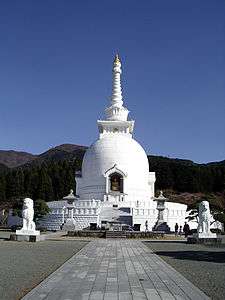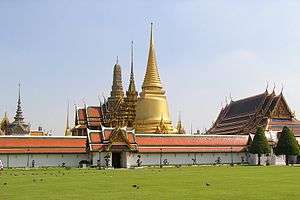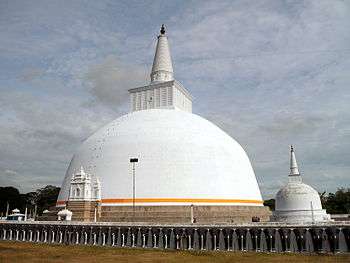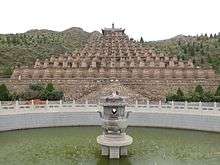Stupa

| Translations of Stupa | |
|---|---|
| Pali | thūpa, cetiya |
| Sanskrit | स्तूप |
| Chinese |
窣堵坡 (Pinyin: Sūdǔpō) |
| Japanese |
舎利塔 (rōmaji: Sharitō) |
| Korean |
솔도파 (RR: Soldopha) |
| Mongolian | Суварга |
| Sinhala |
දාගැබ් (dagoba) |
| Tibetan |
མཆོད་རྟེན་ (chöten) |
| Thai |
สถูป , เจดีย์ (ISO 11940:[1] s̄t̄hūp, cedīy̒) |
| Vietnamese | Phù đồ |
| Glossary of Buddhism | |

| Part of a series on |
| Buddhism |
|---|
 |
|

A stupa (Sanskrit: m.,स्तूप "heap") is a mound-like or hemispherical structure containing relics (śarīra - typically the remains of Buddhist monks or nuns) that is used as a place of meditation.[2]
Description and history
.jpg)
Stupas originated as pre-Buddhist tumuli in which śramaṇas were buried in a seated position[3] called chaitya.[4] After the parinirvana of the Buddha, his remains were cremated and the ashes divided and buried under eight mounds with two further mounds encasing the urn and the embers. The earliest archaeological evidence for the presence of Buddhist stupas dates to the late 4th century BCE in India. Buddhist scriptures claim that stupas were built at least a century earlier. Since it is likely that before this time, stupas were built with non-durable materials such as wood, or even as just burial mounds, little is known about these early stupas, particularly since it has not been possible to identify the original ten monuments. However, some later stupas, such as at Sarnath and Sanchi, seem to be embellishments of earlier mounds. The earliest evidence of monastic stupas dates back to the 2nd century BCE. These are stupas that were built within Buddhist monastic complexes. These stupas replicated older stupas made of baked bricks and timber in stone. Sanchi, Sarnath, Amaravati and Bharhut are examples of stupas that were shaped in stone imitating previously existing wooden parts.
The stupa was elaborated as Buddhism spread to other Asian countries becoming, for example, the chörten of Tibet[5] and the pagoda in East Asia.[6] The pagoda has varied forms that also include bell-shaped and pyramidal styles. In the Western context, there is no clear distinction between the stupa and the pagoda. In general, however, "stupa" is used for a Buddhist structure of India or Southeast Asia while "pagoda" refers to a building in East Asia which can be entered and which may be secular in purpose.
Stupas were built in Sri Lanka soon after Devanampiya Tissa of Anuradhapura converted to Buddhism. The first stupa to be built was the Thuparamaya. Later on, many more were built over the years, some like the Jetavanaramaya in Anuradhapura being one of the tallest ancient structures in the world.
Notable stupas

The earliest archaeological evidence for the presence of Buddhist stupas dates to the late 4th century BCE in India, Sanchi, Sarnath, Amaravati and Bharhut are one of the oldest known stupas. The tallest is the Phra Pathommachedi in Nakhon Pathom Province, Thailand, at a height of 127 metres[7] The Swat Valley hosts one of the well-preserved stupa at Shingardar near Ghalegay and another stupa is located near Barikot and Dharmarajika-Taxila in Pakistan. In Sri Lanka, the ancient city of Anuradhapura includes some of the tallest, most ancient and best preserved stupas in the world, such as Ruwanwelisaya.
The most elaborate stupa is the 8th century Borobudur monument in Java, Indonesia. The upper rounded terrace with rows of bell-shaped stupas contained buddha images symbolizing Arūpajhāna, the sphere of formlessness. The main stupa itself is empty, symbolizing complete perfection of enlightenment. The main stupa is only the crown part of the monument, while the base is pyramidal structure elaborate with galleries adorned with bas relief of scenes derived from Buddhist text depicted the life of Gautama Buddha. Borobudur's unique and significant architecture has been acknowledge by UNESCO as the largest buddhist monument in the world. It is the world’s largest Buddhist temple,[8][9] as well as one of the greatest Buddhist monuments in the world.[10]

Types of stupas
Built for a variety of reasons, Buddhist stupas are classified based on form and function into five types:[11]
- Relic stupa, in which the relics or remains of the Buddha, his disciples and lay saints are interred.
- Object stupa, in which the items interred are objects belonged to the Buddha or his disciples such as a begging bowl or robe, or important Buddhist scriptures.
- Commemorative stupa, built to commemorate events in the lives of Buddha or his disciples.
- Symbolic stupa, to symbolise aspects of Buddhist theology, for example, Borobuddur is considered to be the symbol of "the Three Worlds (dhatu) and the spiritual stages (bhumi) in a Mahayana bodhisattva's character."[11]
- Votive stupa, constructed to commemorate visits or to gain spiritual benefits, usually at the site of prominent stupas which are regularly visited.
Symbolism

"The shape of the stupa represents the Buddha, crowned and sitting in meditation posture on a lion throne. His crown is the top of the spire; his head is the square at the spire's base; his body is the vase shape; his legs are the four steps of the lower terrace; and the base is his throne."[12]
Five purified elements
Although not described in any Tibetan text on stupa symbolism, the stupa may represent the five purified elements:[13]
- The square base represents earth
- The hemispherical dome/vase represents water
- The conical spire represents fire
- The upper lotus parasol and the crescent moon represents air
- The sun and the dissolving point represents the element of space
Construction
To build a stupa, transmissions and ceremonies from a Buddhist teacher is necessary.[14] Which kind of Stupa to be constructed in a certain area is decided together with the teacher assisting in the construction. Sometimes the type of stupa chosen is directly connected with events that have taken place in the area.[14]
Treasury
All stupas contain a treasury filled with various objects. Small clay votive offerings called tsatsas in Tibetan fill a major part of the treasury. Creation of various types of tsatsas is a ceremony itself. Mantras written on paper are rolled into thin rolls, and put into these small clay stupas.[14] Filling the treasury, one layer of Tsa-Tsas are placed, and the empty space between is filled with dry sand. On the new surface appearing, another layer is made, until the entire space of a treasury is full.[14]
The number of tsatsas are dependent on the size of both the treasury and tsatsa, since it should be completely filled. For example, the Kalachakra stupa in southern Spain has approximately 14,000 tsatsas within.[14]
Jewellery and other "precious" objects are also placed in the treasury. It is not necessary that the jewelry be expensive, since it is the symbolic value that is important, not the market price.[14] It is believed that the more objects placed into the stupa, the stronger the energy of the Stupa will be.[14]
Tree of Life
A very important element in every Stupa is the Tree of Life. It is a wooden pole covered with gems and thousands of mantras, and placed in the central channel of the stupa.[14] It is placed here during a ceremony or initiation, where the participants hold colorful ribbons connected to the Tree of Life. Together the participants make their most positive and powerful wishes, which are stored in the Tree of Life. In this way the stupa is charged up, and will start to function.[14]
Benefits
Building a stupa is considered extremely beneficial, leaving very positive karmic imprints in the mind. Future benefits from this action will result in fortunate rebirths. Fortunate worldly benefits will be the result, such as being born into a rich family, having a beautiful body, a nice voice, and being attractive and bringing joy to others and having a long and happy life, in which one's wishes are fulfilled quickly.[15] On the absolute level, one will also be able to reach enlightenment, the goal of Buddhism, quickly.[15]
Destroying a stupa on the other hand, is considered an extremely negative deed, similar to killing.[16] Such an action is explained to create massive negative karmic imprints, leading to massive future problems. It is said this action will leave the mind in a state of paranoia after death has occurred, leading to totally unfortunate rebirths.[16]
Tibetan stupas

There are eight different kinds of stupas in Tibetan Buddhism, each referring to major events in the Buddha's life.[13]
Lotus Blossom Stupa
Also known as "Stupa of Heaped Lotuses" or "Birth of the Sugata Stupa," this stupa refers to the birth of Gautama Buddha. "At birth Buddha took seven steps in each of the four directions"[13] (East, South, West and North). In each direction lotuses sprang, symbolizing the brahmavihāras: love, compassion, joy and equanimity. The four steps of the basis of this stupa is circular, and it is decorated with lotus-petal designs. Occasionally, seven heaped lotus steps are constructed. These refer to the seven first steps of the Buddha.[13]
Enlightenment Stupa
Also known as the Stupa of the Conquest of Mara. This stupa symbolizes the 35-year-old Buddha's attainment of enlightenment under the bodhi tree in Bodh Gaya, where he conquered worldly temptations and attacks manifesting in the form of Mara.[13]
Stupa of Many Doors
Also known as the Stupa of Many Gates. After reaching enlightenment, the Buddha taught his first students in a deer-park near Sarnath. The series of doors on each side of the steps represent the first teachings: the Four Noble Truths, the Six Pāramitās, the Noble Eightfold Path and the Twelve Nidānas.[13]
Stupa of Descent from the God Realm
At 42 years of age, Buddha spent a summer retreat in the Tuṣita Heaven where his mother had taken rebirth. In order to repay her kindness he taught the dharma to her reincarnation. Local inhabitants built a stupa like this in Sankassa in order to commemorate this event. This stupa is characterized by having a central projection at each side containing a triple ladder or steps.[13]
Stupa of Great Miracles

Also known as Stupa of Conquest of the Tirthikas. This stupa refers to various miracles performed by the Buddha when he was 50 years old. Legend claims that he overpowered maras and heretics by engaging them in intellectual arguments and also by performing miracles. This stupa was raised by the Lichavi kingdom to commemorate the event.[13]
Stupa of Reconciliation
This stupa commemorates the Buddha's resolution of a dispute among the sangha. A stupa in this design was built in the kingdom of Magadha, where the reconciliation occurred. It has four octagonal steps with equal sides.[13]
Stupa of Complete Victory
This stupa commemorates Buddha's successful prolonging of his life by three months. It has only three steps, which are circular and unadorned.[13]
Stupa of Nirvana
This stupa refers to the death of the Buddha, when he was 80 years old. It symbolizes the Buddha's complete absorption into the highest state of mind. It is bell-shaped and usually not ornamented.[13]
Kalachakra stupa
A ninth kind of stupa exists, the Kalachakra stupa. Its symbolism is not connected to events in the Buddha's life, but instead to the symbolism of the Kalachakra Tantra, created to protect against negative energies.[17]
Swat District
Swat District is a small place with large number of ancient Stupas. The largest stupa of the Indian subcontinent is based in Shingardar.
Gallery

 Stupa surrounded by four lion-crowned pillars. Gandhara, 2nd century AD.
Stupa surrounded by four lion-crowned pillars. Gandhara, 2nd century AD.- Shingardar stupa, Swat valley
- Amlukdara stupa, near Barikot Swat
 Dro-dul Chorten - Gangtok, Sikkim
Dro-dul Chorten - Gangtok, Sikkim
 Dhamek Stupa in Sarnath.
Dhamek Stupa in Sarnath. Swayambhunath, also known as Monkey Temple, is an ancient religious complex atop a hill in the Kathmandu Valley, Nepal.
Swayambhunath, also known as Monkey Temple, is an ancient religious complex atop a hill in the Kathmandu Valley, Nepal.
 Ruwanwelisaya in the sacred city of Anuradhapura, Sri Lanka.
Ruwanwelisaya in the sacred city of Anuradhapura, Sri Lanka.

_at_Bojjannakonda.jpg) A rock cut and semi brick construction ruins of Maha Chaitya(stupa) at Bojjannakonda, Andhra Pradesh, India
A rock cut and semi brick construction ruins of Maha Chaitya(stupa) at Bojjannakonda, Andhra Pradesh, India

- Different architectural features that comprise Shwedagon Pagoda and similar Mon-style stupas, in Yangon, Myanmar.

 Evolution of the Butkara stupa in Pakistan, through the Mauryan, Indo-Greek, Indo-Scythian and Kushan periods.
Evolution of the Butkara stupa in Pakistan, through the Mauryan, Indo-Greek, Indo-Scythian and Kushan periods. A stupa at Dambulla golden temple, Sri Lanka
A stupa at Dambulla golden temple, Sri Lanka- Tissamaharama stupa across the paddy fields in Tissamaharama, Sri Lanka

See also
References in popular culture
- In Tintin in Tibet, Captain Haddock is told that one should always walk left of a chorten (Tibetan for 'stupa') when crossing one, because walking right unleashes demons. This is an invention of the author.
References
- ↑ Google Translate forum: What Phonetic System does Google Translate use for Thai
- ↑ Encyclopedia.com. Credited to James Stevens Curl, A Dictionary of Architecture and Landscape Architecture, 2000, originally published by Oxford University Press 2000.
- ↑ "Buddhist Art and Architecture: Symbolism of the Stupa / Chorten". 2006-08-14. Retrieved 2013-01-07.
- ↑ "THE BUDDHIST STUPA: ORIGIN AND DEVELOPMENT". 2005-01-13. Retrieved 2013-01-07.
- ↑ "Stupa - Bhutanese, Nepalese, Tibetan Style Chortens or Stupa is the symbol of enlightened mind". Bhutan Majestic Travel. 2013-01-17. Retrieved 2013-01-17.
- ↑ The Columbia Encyclopedia, Sixth Edition. Columbia University Press
- ↑ http://templesinthailand.com/wat-phra-pathom-chedi/
- ↑ "Largest Buddhist temple". Guinness World Records. Guinness World Records. Retrieved 27 January 2014.
- ↑ Purnomo Siswoprasetjo (July 4, 2012). "Guinness names Borobudur world's largest Buddha temple". The Jakarta Post. Retrieved 27 January 2014.
- ↑ "Borobudur Temple Compounds". UNESCO World Heritage Centre. UNESCO. Retrieved 28 December 2008.
- 1 2 Le Huu Phuoc (March 2010). Buddhist Architecture. Grafikol. p. 140. ISBN 978-0-9844043-0-8. Retrieved 8 December 2011.
- ↑ "Introduction to stupas". stupa.org. Retrieved 2009-04-18.
- 1 2 3 4 5 6 7 8 9 10 11 Beer, Robert: The Encyclopedia of Tibetan Symbols and Motifs (2004) Serindia Publications Inc. ISBN 1-932476-10-5
- 1 2 3 4 5 6 7 8 9 "Miracle Stupa - Stupa". stupa.pl. Retrieved 2009-04-18.
- 1 2 "Benefits Resulting from the Building of Stupas". stupa.org. Retrieved 2009-04-18.
- 1 2 Article: Lopon Tsechu Rinpoche: The Four Thoughts which Turn the Mind from Samsara. BUDDHISM TODAY, Vol.5, 1998. Available online
- ↑ "Kalachakra Stupa". karmaguen.org. Archived from the original on December 5, 2008. Retrieved 2009-04-18.
- ↑ "ANCIENT STUPAS IN SRI LANKA – LARGEST BRICK STRUCTURES IN THE WORLD" (PDF). stupa.org. Retrieved 2011-07-29.
Further reading
- Harvey, Peter (1984). The Symbolism of the Early Stūpa, Journal of the International Association of Buddhist Studies 7 (2), 67-94
- Mitra, D. (1971). Buddhist Monuments. Sahitya Samsad: Calcutta. ISBN 0-89684-490-0.
- Smith, Vincent Arthur (1901). The Jain stupa and other antiquities of Mathura. Allahabad.
| Wikimedia Commons has media related to Stupas. |
External links
- The Stupa Information Page
- Boudhanath Stupa at Kathmandu Nepal
- The Great Stupa of Universal Compassion, under construction in Bendigo, Victoria, Australia
- Stupa at Rigpawiki